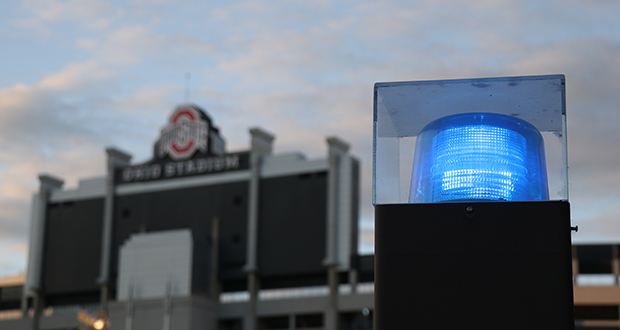
The university released its 2018 Annual Security Report on Friday. Credit: Jack Westerheide | Managing Editor for Design
Reported rapes increased for the second year in a row on Ohio State’s campus according to the university’s annual crime report, released Friday.
Reports of rape on campus saw an increase for the second year in a row as the total rose from 57 in 2016 to 71 last year. There were 26 rapes reported in 2015. The university attributes this continued rise to a growing willingness among the community to come forward and report incidents, as well as a 30 percent larger campus population with the North Campus residential halls fully up and running.
Melinda Benson, assistant compliance director and deputy Clery Act coordinator, said more students are more willing to come forward because they are wanting to seek help, and they want it to stop.
“I think in this current age that we’re in with ‘Me Too’ and everything, people are realizing that if you come forward and say something, someone will help you, and that’s a really positive message,” Benson said.
The 2018 Annual Security Report, which reflects 2017 statistics, fulfills the university’s requirement under the Clery Act that crime statistics are disclosed to the campus community every year by Oct. 1 and shows increases in a number of notable categories including rape, fondling, domestic violence, dating violence, stalking and burglary.
The university announced a new mandatory, online sexual assault training for all students on Thursday. Title IX and Clery Act Coordinator Kellie Brennan said the training is a result of a motion passed by the University Senate in March.
Rape, domestic and dating violence, fondling and stalking
Brennan said the Campus Climate Survey, which is sent out every year and responded to anonymously, continues to see a roughly static number of students who experience sexual assault.
“So we know that the incidents of sexual assault is not going up,” Brennan said. “It’s either staying steady or it’s slightly decreasing, but our reporting numbers are going up, and that is a good thing.”
According to Ohio State’s 2017 Campus Climate Survey, the number of students who were “somewhat or very knowledgeable” about where to report sexual assault or misconduct rose from 47.8 percent in 2015 to 77 percent in 2017.
Reports of rape on campus are divided by those that occured in residence halls and those that did not. In 2016, 47 occurred in residence halls while 10 occurred elsewhere on campus. Both those numbers rose in 2017 with 57 reports of rape in residence halls and 14 outside of residence halls.
The university attributes the rise in reported instances of fondling, domestic and dating violence and stalking to the same factors: increased willingness to report and a larger campus population.
Fondling, which is categorized as any inappropriate touching that police are alerted to, saw an increase from 22 cases in 2016 to 29 in 2017. Meanwhile, domestic violence reports rose from 10 to 21 and dating violence from 17 to 44.
Reports of stalking — defined as any unwanted excessive communication or interaction that could cause someone to fear for their safety — have increased by 40 over the past three years with reports rising from 18 to 58 from 2015 to 2017.
Dan Hedman, a spokesman for the university, said the understanding of what stalking is — that it can be digital communication with the victim or those close to the victim and not just physical following or observing of the victim — has helped cause the increase in reports.
Burglary
Reports of burglary saw a sharp increase from 19 in 2016 to 49 in 2017 and Brennan said this is largely due to more suites in residential halls on campus and how burglary is reported under Clery guidelines.
Brennan said when a burglary occurs in a suite, each separate room in the suite would be a separate statistic.
For example, under the Ohio Revised Code, someone entering a suite containing four rooms and grabbing multiple items would be reported as a theft. But under Clery guidelines when someone enters a residential hall suite, a separate burglary is reported for each person whose property is taken.
In a press release accompanying the release of the report the university said a trend of burglaries was identified by the University Police in November 2017 and a public safety notice was sent out to the community and that the resulting investigation led to an arrest being made.
“Safety of students, faculty and staff remain our top priority,” Monica Moll, director of the Department of Public Safety, said in the press release. “We continue to hire additional police officers and invest in safety tools to provide proactive policing and security services to campus residents and for major events.”
The university released a new video on surviving an active aggressor and announced a new safety app, Rave Guardian, this fall.
Alcohol and drug violations
Alcohol Law Violation arrests on campus saw an increase from 103 reports to 127 from 2016 to 2017, while violations that resulted in disciplinary referrals, which are cases turned over to student conduct, decreased from 1,931 to 1,844.
Drug Law Violation arrests on campus also saw an increase from 31 to 41 cases from 2016 to 2017, with disciplinary referrals increasing from 259 to 313.
“Our first preference is to do a referral than to arrest the students, so you can see those numbers are low,” said Kimberly Spears-McNatt, interim University Police chief.
Hate crimes
Hate crimes saw a significant drop in the report due to the unnaturally high number of cases in 2016 due to the November 2016 attack at Ohio State.
The November attack spurred a rise in hate crime cases from four in 2015 to 32 in 2016, which then fell back down to 10 in 2017.


